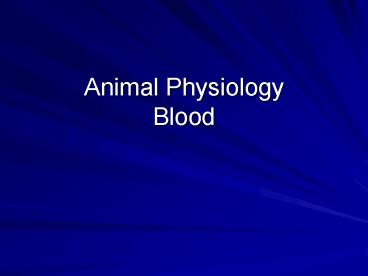Animal Physiology Blood - PowerPoint PPT Presentation
1 / 20
Title:
Animal Physiology Blood
Description:
Animal Physiology Blood What is blood? Hemolymph vs blood Major Functions of Blood Gas Transport Nutrient Transport Waste Transport Transport Chemical Signals ... – PowerPoint PPT presentation
Number of Views:259
Avg rating:3.0/5.0
Title: Animal Physiology Blood
1
Animal PhysiologyBlood
2
What is blood?
- Hemolymph vs blood
Open circulatory system has hemolymph
Closed circulatory system Contains blood
3
Major Functions of Blood
- Gas Transport
- Nutrient Transport
- Waste Transport
- Transport Chemical Signals
- Transport Heat
- Generate hydraulic force (e.g., spider legs)
- Coagulation
4
Composition of Blood
- Plasma
- 55 of total blood volume
- 90 water
- 7-8 soluble proteins albumins
- -1-2 electrolytes, dissolved ions
- -1-2 transported materials nutrients, metabolic
intermediates, gases, hormones
5
Composition of Blood
- Cellular Components
- Erythrocytes (red blood cells) (4.7-5.2M/mm3)
- Leucocytes (white blood cells) (5-7k/mm3)
6
Viewed another way
7
Gas Transport
- Why not just use water?
- Binding pigments increase oxygen carrying
capacity - 0.2 ml O2 in 100 ml blood 2 ml O2/l
- vs
- 20.0 ml HbO2 in 100 ml blood 200 ml HbO2/l
8
Hemoglobin
- 4 globulin subunits, each with a heme group
- Globulin subunits in adult human hemoglobin have
2a 2b fetal human hemoglobin has two a and two
g subunits - Can be either erythrocytic or in plasma
9
Other Binding Proteins
- Chlorocurorin green in dilute solution, globin
and iron/porphyrin ring found in marine
annelids - Hemocyanin blue when oxygenated, protein and
copper found in some arthropods and mollusks - Hemerythrin violet-pink when oxygenated iron
bound directly to protein (no porphyrin ring)
found in sipunculids, priapulids, brachiopods and
one family of marine annelids
10
Gas Transport different respiratory pigments
11
Sizes of Pigments Intracellular vs Extracellular
In cells In cells In Plasma In Plasma
Pigment Animal Molecular weight Animal Molecular weight
Hemoglobin Mammals Birds Fish Cyclostomes Polychaetes Echinoderms Molluscs Insects 68,000 68,000 68,000 19,100 23,100 36,000 33,600 34,000 Oligochaetes Polychaetes Molluscs Insects 2,946,000 3,000,000 3,000,000 31,400
Chlorocruorin Polychaetes 3,400,000
Hemerythrin Sipunculus Phascolosoma 66,000 120,000
Hemocyanin Gastropods Cephalopods Arachnids Crustacea 6,680,000 2,791,000-3,316,000 1,300,000 397,000-812,000
12
Blood Binding
- Cooperative binding
- What is pO2?
- How do you make these curves, anyway?
13
Affinity varies among species
14
Factors that affect binding
- Bohr Effect (CO2 lowers O2 affinity)
15
Bohr effect varies among species
16
Factors that affect binding
- Root effect (CO2 depresses O2 saturation levels
in some species)
17
Factors that affect binding
- Organic phosphates reduce O2 affinity
- 2,3-diphosphoglycerate (DPG) in mammals
- Inositol phosphate in birds
- Adenosine triphosphate (ATP) or guanosine
triphosphate (GTP) in fish - Significant in fetal development and acute
response to changes in oxygen partial pressure
(e.g., altitude)
18
Blood also facilitates CO2 transport
19
Facilitated Diffusion
- Hemoglobin facilitates diffusion of oxygen
- Carbon dioxide transport is facilitated by
several factors - Hb binding of CO2
- Hb buffering of H ions
- Carbonic anhydrase
- Chloride-bicarbonate exchange (band III)
20
For Thursday
How does a gutless worm get so big, so fast?































